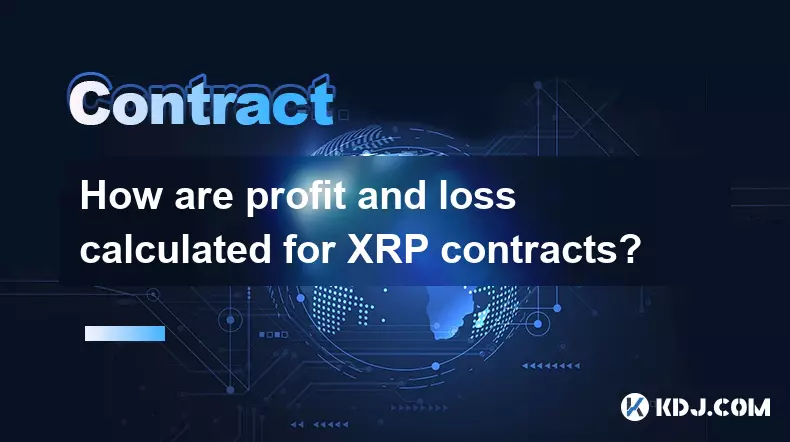-
 bitcoin
bitcoin $122288.232522 USD
0.16% -
 ethereum
ethereum $4480.662914 USD
-0.22% -
 xrp
xrp $2.962747 USD
-2.32% -
 tether
tether $1.000120 USD
-0.05% -
 bnb
bnb $1145.654223 USD
-2.07% -
 solana
solana $227.105217 USD
-1.67% -
 usd-coin
usd-coin $0.999548 USD
-0.02% -
 dogecoin
dogecoin $0.250875 USD
-2.04% -
 tron
tron $0.340654 USD
-0.49% -
 cardano
cardano $0.837968 USD
-2.52% -
 hyperliquid
hyperliquid $48.960449 USD
0.06% -
 chainlink
chainlink $22.049280 USD
-1.33% -
 ethena-usde
ethena-usde $1.000404 USD
0.02% -
 sui
sui $3.586212 USD
0.20% -
 avalanche
avalanche $29.894916 USD
-4.18%
How are profit and loss calculated for XRP contracts?
XRP contract profits depend on price changes, leverage, funding rates, fees, and mark price mechanics, with unrealized P&L updating in real time and realized P&L settled upon closure after accounting for costs and funding.
Sep 26, 2025 at 03:54 am

Understanding XRP Contract Mechanics
1. XRP contracts operate within the framework of perpetual futures or standardized futures agreements on cryptocurrency derivatives exchanges. These contracts allow traders to speculate on the price movement of XRP without owning the underlying asset. Each contract has a defined size, often expressed in terms of XRP value relative to a base currency like USDT or USD.
2. The calculation of profit and loss begins with the difference between the entry price and exit price of the position. This difference is multiplied by the number of contracts held or the notional value controlled by the trader. Leverage amplifies both gains and losses, meaning even small price movements can result in significant outcomes depending on position size.
3. Funding rates play a critical role in perpetual contracts. Traders either pay or receive funding based on whether they hold long or short positions and the prevailing market bias. These periodic payments, typically every 8 hours, are factored into net profitability over time, especially for positions held across multiple funding intervals.
4. Mark price is used to prevent manipulation and unfair liquidations. Exchanges calculate this using external index prices and apply it when determining unrealized P&L and triggering liquidations. Using mark price instead of last traded price ensures stability during volatile market conditions.
5. Fees associated with opening and closing positions also impact net profit or loss. Taker fees apply when removing liquidity from the order book, while maker fees are usually lower or rebated when adding liquidity. These costs must be deducted from gross gains to determine actual returns.
Calculating Realized and Unrealized Gains
1. Unrealized profit or loss refers to the current value of an open position based on live market data. It fluctuates as the XRP price changes and is calculated by taking the difference between the current mark price and the entry price, then multiplying by the contract quantity.
For a long position: (Current Mark Price - Entry Price) × Number of Contracts = Unrealized P&LFor a short position: (Entry Price - Current Mark Price) × Number of Contracts = Unrealized P&L2. Once a position is closed, the unrealized amount becomes realized. At this point, trading fees are subtracted, and funding payments made or received during the holding period are included in the final tally.
3. In cross-margin systems, unrealized losses reduce available balance and equity, potentially leading to margin calls or automatic liquidation if equity drops below maintenance margin requirements.
4. Isolated margin mode limits risk to a specific collateral amount allocated to the position. Profit or loss directly affects that isolated account balance without impacting other positions.
5. Some platforms display P&L percentages alongside absolute values, helping traders assess performance relative to their initial margin commitment.
Risk Factors Influencing XRP Contract Outcomes
1. Volatility in the XRP market can lead to rapid shifts in P&L. News related to regulatory developments, exchange listings, or Ripple Labs litigation significantly impacts price action, affecting open positions unpredictably.
2. Liquidation engines monitor positions continuously. When losses erode margin beyond a threshold, the system forcibly closes the trade, resulting in total or partial loss of collateral. Partial liquidations may occur on certain platforms during cascading margin breaches.
3. Slippage during high volatility can alter exit prices from expected levels, particularly when market orders are used near key support or resistance zones.
4. Time decay does not affect traditional perpetual contracts, but prolonged holding incurs cumulative funding expenses or earnings, which subtly shift break-even points over time.
5. Exchange-specific rules such as insurance funds, clawback mechanisms, or auto-deleveraging (ADL) can influence final settlement outcomes during extreme market stress, altering how much of a profit is actually credited or loss absorbed.
Frequently Asked Questions
How is leverage reflected in XRP contract profits?Leverage multiplies the effect of price changes on your margin. A 10x leveraged position will see a 1% move in XRP price translate into a 10% gain or loss on the invested capital. Higher leverage increases sensitivity, making precise entry and risk controls essential.
What happens to my P&L if the funding rate is positive?If you hold a long position and the funding rate is positive, you pay the rate to short holders. This reduces your net profit or increases your loss over time. Conversely, short positions receive the payment, improving their net outcome when funding is positive.
Can I calculate my break-even price on an XRP contract?Yes. For a long position, add trading fees and any anticipated funding costs to your entry price. For a short, subtract these from the entry price. The resulting figure indicates the price level where you begin generating net profit.
Why does my P&L differ between exchanges for the same XRP position?Differences arise due to variations in mark price sources, fee structures, funding rate calculations, and contract specifications such as inverse vs. linear payouts. Always verify the exact formula used by your chosen platform.
Disclaimer:info@kdj.com
The information provided is not trading advice. kdj.com does not assume any responsibility for any investments made based on the information provided in this article. Cryptocurrencies are highly volatile and it is highly recommended that you invest with caution after thorough research!
If you believe that the content used on this website infringes your copyright, please contact us immediately (info@kdj.com) and we will delete it promptly.
- BlockDAG, DOGE, HYPE Sponsorship: Crypto Trends Shaping 2025
- 2025-10-01 00:25:13
- Deutsche Börse and Circle: A StableCoin Adoption Powerhouse in Europe
- 2025-10-01 00:25:13
- BlockDAG's Presale Buzz: Is It the Crypto to Watch in October 2025?
- 2025-10-01 00:30:13
- Bitcoin, Crypto, and IQ: When Genius Meets Digital Gold?
- 2025-10-01 00:30:13
- Stablecoins, American Innovation, and Wallet Tokens: The Next Frontier
- 2025-10-01 00:35:12
- NBU, Coins, and Crypto in Ukraine: A New Yorker's Take
- 2025-10-01 00:45:14
Related knowledge

What is the difference between futures and perpetual contracts for Bitcoin?
Oct 02,2025 at 11:54pm
Understanding Bitcoin Futures Contracts1. Bitcoin futures are derivative instruments that allow traders to speculate on the future price of Bitcoin at...

What is the best time to trade PEPE contracts?
Oct 03,2025 at 11:54am
Understanding PEPE Contract Volatility1. PEPE contracts exhibit extreme price fluctuations due to their meme-based nature and low market cap. Trading ...

What are the common mistakes to avoid with Bitcoincoin contracts?
Oct 03,2025 at 08:54am
Emerging Trends in the Cryptocurrency Market1. Decentralized finance (DeFi) platforms continue to expand their influence across the blockchain ecosyst...

What is the maintenance margin for Bitcoin contracts?
Oct 02,2025 at 01:36am
Decentralized Exchanges Gain Momentum in 20241. Decentralized exchanges (DEXs) have seen a significant rise in trading volume, surpassing centralized ...

How to use technical analysis for trading XRP contracts?
Oct 03,2025 at 01:18pm
Understanding Price Patterns in XRP Futures1. Identifying chart patterns such as triangles, head and shoulders, and double tops or bottoms can provide...

What does "longing" PEPE contracts mean?
Oct 03,2025 at 11:54pm
Understanding Decentralized Exchanges in the Crypto Ecosystem1. Decentralized exchanges (DEXs) operate without a central authority, allowing users to ...

What is the difference between futures and perpetual contracts for Bitcoin?
Oct 02,2025 at 11:54pm
Understanding Bitcoin Futures Contracts1. Bitcoin futures are derivative instruments that allow traders to speculate on the future price of Bitcoin at...

What is the best time to trade PEPE contracts?
Oct 03,2025 at 11:54am
Understanding PEPE Contract Volatility1. PEPE contracts exhibit extreme price fluctuations due to their meme-based nature and low market cap. Trading ...

What are the common mistakes to avoid with Bitcoincoin contracts?
Oct 03,2025 at 08:54am
Emerging Trends in the Cryptocurrency Market1. Decentralized finance (DeFi) platforms continue to expand their influence across the blockchain ecosyst...

What is the maintenance margin for Bitcoin contracts?
Oct 02,2025 at 01:36am
Decentralized Exchanges Gain Momentum in 20241. Decentralized exchanges (DEXs) have seen a significant rise in trading volume, surpassing centralized ...

How to use technical analysis for trading XRP contracts?
Oct 03,2025 at 01:18pm
Understanding Price Patterns in XRP Futures1. Identifying chart patterns such as triangles, head and shoulders, and double tops or bottoms can provide...

What does "longing" PEPE contracts mean?
Oct 03,2025 at 11:54pm
Understanding Decentralized Exchanges in the Crypto Ecosystem1. Decentralized exchanges (DEXs) operate without a central authority, allowing users to ...
See all articles










































































